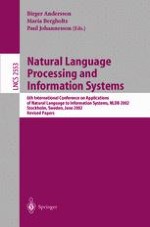The workshop on Applications of Natural Language to Information Systems (NLDB)hassince1995providedaforumforacademicandindustrialresearchers and practitioners to discuss the application of natural language to both the development and use of software applications. Theuseofnaturallanguageinrelationtosoftwarehascontributedtoimpr- ing the development of software from the viewpoints of both the developers and the users. Developers bene?t from improvements in conceptual modeling, so- ware validation, natural language program speci?cations, and many other areas. Users bene?t from increased usability of applications through natural language query interfaces, semantic webs, text summarizations, etc. The integration of natural language and information systems has been a - search objective for a long time now. Today, the goal of good integration seems not so far-fetched. This is due mainly to the rapid progress of research in natural language and to the development of new and powerful technologies. The in- gration of natural language and information systems has become a convergent point towards which many researchers from several research areas are focussing.
